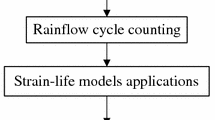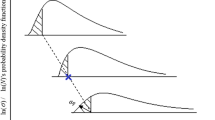Abstract
The fatigue lives of materials and structures at different strain levels show heteroscedasticity. In addition, when the number of test specimens is insufficient, the fatigue strength coefficient and fatigue ductility coefficient of the fitting parameters in the total strain life equation may not have definite physical significance. In this work, a maximum likelihood method for estimating probabilistic strain amplitude–fatigue life curves is presented based on the fatigue lives at different strain levels. The proposed method is based on the general basic assumption that the logarithm of fatigue life at an arbitrary strain level is normally distributed. The relationship among the parameters of total strain life equation, monotonic ultimate tensile stress and percentage reduction of area is adopted. The presented approach is finally illustrated by two applications. It is shown that probabilistic strain amplitude–fatigue life curves can be easily estimated based on the maximum likelihood method. The results show that fatigue lives at different strain levels have heteroscedasticity and the values of fatigue strength coefficient and fatigue ductility coefficient obtained by the proposed method are close to those of the true tensile fracture stress and true tensile fracture strain.



















Similar content being viewed by others
Change history
22 November 2018
In all the articles in Acta Mechanica Solida Sinica, Volume 31, Issues 1–4, the copyright is incorrectly displayed as “The Chinese Society of Theoretical and Applied Mechanics and Technology ” where it should be “The Chinese Society of Theoretical and Applied Mechanics”.
References
Ramua P, Arul S. Estimating probabilistic fatigue of Nitinol with scarce samples. Int J Fatigue. 2016;85:31–9.
Spindel JE, Haibach E. The method of maximum likelihood applied to the statistical analysis of fatigue data. Int J Fatigue. 1979;1(2):81–8.
Ling J, Pan J. A maximum likelihood method for estimating \(P\text{- }S\text{- }N\) curves. Int J Fatigue. 1997;19(5):415–9.
Goglio L, Rossetto M. Comparison of fatigue data using the maximum likelihood method. Eng Fract Mech. 2004;71:725–36.
Paolino DS, Tridello A, Chiandussi G, et al. S–N curves in the very-high-cycle fatigue regime: statistical modeling based on the hydrogen embrittlement consideration. Fatigue Fract Eng Mater Struct. 2016;39:1319–36.
Castillo E, Fernández-Canteli A, Hadi AS. On fitting a fatigue model to data. Int J Fatigue. 1999;21:97–106.
Castillo E, Ramos A, Koller R, et al. A critical comparison of two models for assessment of fatigue data. Int J Fatigue. 2008;30:45–57.
Pollak RD, Palazotto AN. A comparison of maximum likelihood models for fatigue strength characterization in materials exhibiting a fatigue limit. Probab Eng Mech. 2009;24:236–41.
Baldwin JD, Thacker JG. A strain-based fatigue reliability analysis method. J Mech Des. 1995;117:229–34.
Williams CR, Lee Y-L, Rilly JT. A practical method for statistical analysis of strain–life fatigue data. Int J Fatigue. 2003;25:427–36.
Apetre N, Arcari A, Dowling N, et al. Probabilistic model of mean stress effects in strain–life fatigue. Procedia Eng. 2015;114:538–45.
Zhao J, Tang J, Wu HC. A reliability assessment method in strain-based fatigue life analysis. J Press Vessel Technol. 1999;120:99–104.
Zhao J, Tang J, Wu HC. A generalized random variable approach for strain-based fatigue reliability analysis. J Press Vessel Technol. 2000;122:156–61.
Zhao YX. A methodology for strain-based fatigue reliability analysis. Reliab Eng Syst Saf. 2000;70:205–13.
Beretta S, Foletti S, Rusconi E, et al. A log-normal format for failure probability under LCF: concept, validation and definition of design curve. Int J Fatigue. 2016;82:2–11.
Wang P, Yang X, Peng D. Effects of cyclic loading performance on grain boundary motion of nanocrystalline Ni. Metall Mater Trans A. 2017;48:4977–89.
Fu H, Liu C. Integral inference method for \(\varepsilon \text{- }N\) and \(P\text{- }\varepsilon \text{- }N\) curves. J Aerosp Power. 2006;21(6):957–61.
Wang Y, Li H, Yuan S, et al. A method for determination of parameters in total strain life equation. J Aerosp Power. 2014;29(4):0881–6 (in Chinese).
Bing T, Lixun C, Haifeng L. Effect of punctate conglomeration on uniaxial fatigue behavior of 42CrMoA. Build Sci Res Sichuan. 1999;3:56–60 (in Chinese).
Wang W. Research on prediction model for disc LCF life and experiment assessment methodology. Nanjing University of Aeronautics and Astronautics, 2006, Nanjing (in Chinese).
Author information
Authors and Affiliations
Corresponding author
Additional information
This work is supported by the National Natural Science Foundation of China (No. 51475022).
Rights and permissions
About this article
Cite this article
Feng, H., Wang, Y. & Jiang, X. A Maximum Likelihood Method for Estimating Probabilistic Strain Amplitude–Fatigue Life Curves. Acta Mech. Solida Sin. 31, 80–93 (2018). https://doi.org/10.1007/s10338-018-0002-1
Received:
Revised:
Accepted:
Published:
Issue Date:
DOI: https://doi.org/10.1007/s10338-018-0002-1




